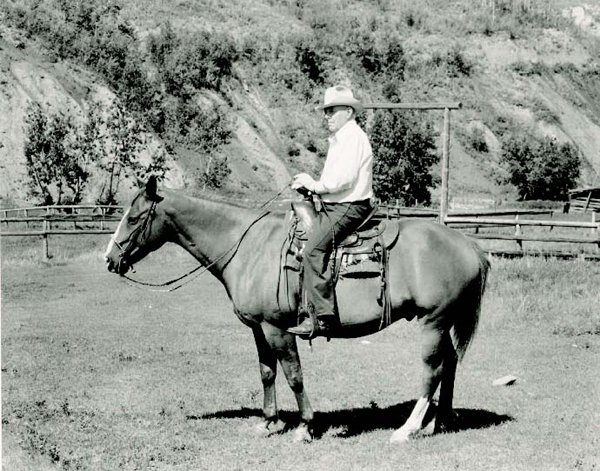Comes A Horseman
When Bert Sheppard was growing up, there were still a good many old-time cowboys living in the High River area of southwestern Alberta. They were men who remembered the huge trail drives north across the U.S. border with herds of shorthorns and Texas longhorns numbering in the thousands. These cowboys hailed from Texas, Mexico, England and Ontario as well as most points in between; men riding the Alberta rangelands in the days “before the wire.”
Bert learned the ways of working cattle from these veterans who had ridden a few thousand miles “between a slick fork and a high cantle.” They must have been good teachers, for in time Bert came to be known as one of the top Hereford breeders in Canada and a good hand with horses.
Cowboys who knew him remember that he started his own colts and put a solid finish on his stock horses. Working horses was one of the most enjoyable aspects of ranching for Bert and his remuda was of mixed blood in the early days because they wintered better on the range.
 |
| Bert Sheppard on his favourite horse, Snoopy, on his Riverbend Ranch along the Highwood River in southern Alberta |
In 1924, Bert bought his first herd of Herefords and ten years later, he purchased the Riverbend Ranch near Longview. In 1939, he became partners with Canadian author R.M. Patterson of the Buffalo Head Ranch, along with the Bews brothers of the Y Cross, and they bought the TL Ranch, an outfit that has a unique history of its own.
Tom Lynch located the TL on a small north side flat up Sullivan Creek in the 1880s. Lynch was a famous dealer and drover who trailed thousands of cattle and horses into the Northwest in those days, having trailed horses from Idaho to Edmonton before the arrival of the Mounties in 1874.
Tom Lynch died in 1891 and Mrs. Lynch sold the holdings but by 1900, the ranch buildings stood derelict and rustlers moved in. Near the ranch there was a big hill called the Camel’s Hump, and every trail in the area could be seen from the top. It was easy for a lookout to keep watch while brands were changed in the corral. The TL had become a rustler’s roost.
The TL became known for strange occurrences that took place in the night. Well-bred horses appeared in the pasture in the mornings, disappearing the following evening, but the riders were never seen. Local ranchers suspected that these mysterious horses arrived and left because rustlers were using Lynch’s trail system to move them. Then as suddenly as it had begun, the activity at the TL stopped.
In 1902, Ed Marston was riding up Sullivan Creek when he smelled smoke. Arriving at the TL, he found the house in flames and fresh tracks in the snow leading away from the fire. It was rumoured the fire had been set by a rancher victimized by the rustlers one too many times. The ranch changed hands many times after this, and the original home site was abandoned. The rustlers themselves were forgotten.
In the early 1930s, Bert remembers that a very old log cabin was discovered concealed in a grove of spruce trees along the Lynch Trail. Nearby was a hidden grass valley where horses could be congregated before being moved south into Idaho or Montana. Bert recalls that when the cabin was found, there were remnants of cowboy life littered about, such as used .44-40 brass casings, some old boots and a red-collared yellow Fish-brand riding slicker. In the vicinity were the graves of two men whose identities have long since been lost in the shadows of history. The fate of the rustlers had been discovered. It was apparent, Bert pointed out, that the Canadian West wasn’t as tame as some folks would claim.
Bert had his own series of adventures while working at the TL and one such occurrence took place in the summer while he was checking cattle.
One morning, after packing up, he dropped a loop over the saddle horn and headed off down the trail. All was going well until the packhorse pulled back near a small tree, lost his footing and slid down a slope. The packhorse and Bert were now in danger of getting hung up or going over the edge. Carefully, he edged his saddle horse backward and into the tree, so that the horse’s weight was taken up by the trunk. The packhorse got back to his feet, the wreck was sorted out and off they went again. As Bert remembered, “It’s best not to look down when you’re hung up in a tree with two horses.”
In 1950, Bert was hired to manage the OH Rio Alto Ranch, founded in 1883. Seven years later he sold off his TL holdings to become a full partner in the OH. He continued to pass on his knowledge, gleaned from the great cattlemen of the Canadian West, but in fact, few could match his roping skill. At one branding he heeled three calves a minute, probably a record to this day. In 1963, Bert retired from active management and wrote several books about ranching still sought by collectors.
Although legally blind by the 1980s, he continued to ride his favourite horse, Snoopy, in his California-style slick fork built on a White River tree. Bert Sheppard died in 1999, having lived his whole life along the Highwood River and standing as a giant among the great cattlemen of the West.













